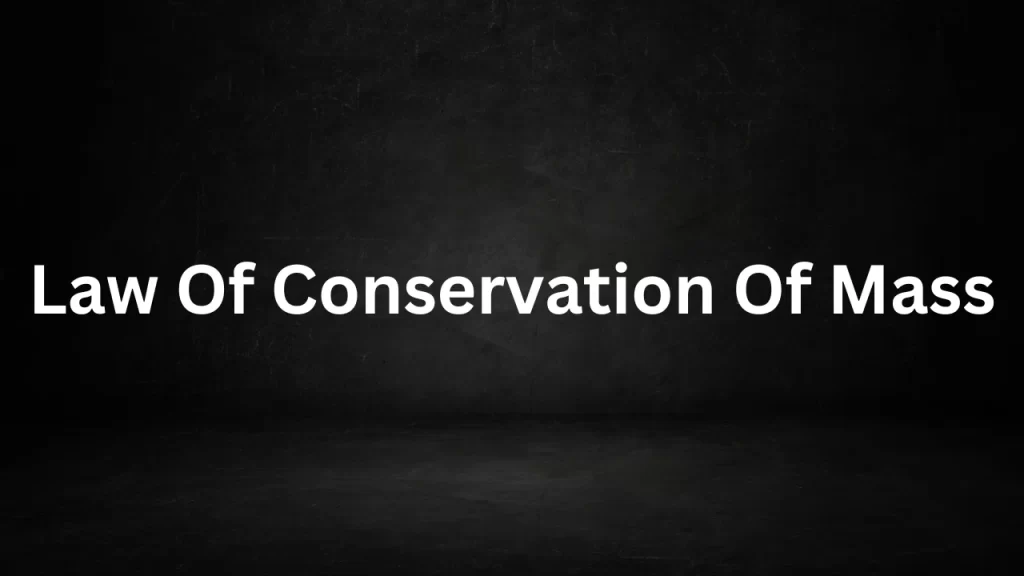Tag: law of conservation of mass reading comprehension
Law Of Conservation Of Mass
Law Of Conservation Of Mass: The Law of Conservation of Mass is one of the fundamental principles that underpin the field of chemistry. It asserts that within a closed system, mass remains conserved and cannot be either generated or eliminated.
This law was first formulated by Antoine Lavoisier, a French chemist, in the late 18th century and has since become a cornerstone of modern chemistry. In this article, we will explore the Law of Conservation of Mass, its historical context, its significance, and its applications in various scientific disciplines.

Law Of Conservation Of Mass
Historical Context
Prior to the development of the Law of Conservation of Mass, the predominant theory in chemistry was the phlogiston theory. This theory proposed the existence of a hypothetical substance called “phlogiston,” which it suggested was released during combustion. This theory failed to explain various chemical reactions accurately.
Antoine Lavoisier’s groundbreaking experiments in the late 18th century provided the experimental evidence needed to disprove the phlogiston theory and establish the Law of Conservation of Mass. His meticulous measurements and observations during chemical reactions led to the realization that the total mass of substances involved in a chemical reaction remained constant, regardless of the changes in their forms.
The Law Explained
The Law of Conser of Mass can be summarized as follows:
“In a closed system, the total mass of reactants before a chemical reaction is equal to the total mass of products after the reaction.”
This signifies that in a chemical reaction, atoms are neither generated nor annihilated; rather, they undergo reorganization to create new compounds. The law emphasizes the importance of balancing chemical equations, where the number of atoms of each element on the reactant side must be equal to the number on the product side.
Significance of the Law
- Fundamental Principle: The Law of Conser of Mass is a fundamental principle in chemistry that lays the foundation for understanding and predicting chemical reactions.
- Chemical Equations: It is crucial for writing and balancing chemical equations accurately, ensuring that all reactants and products are accounted for.
- Stoichiometry: The law is essential for stoichiometry, which involves calculating the quantities of reactants and products in chemical reactions.
- Mass Spectrometry: In modern analytical chemistry, mass spectrometry techniques are used to measure the mass of reactants and products, confirming the law’s validity.
Applications
- Chemical Industry: The law is fundamental in chemical manufacturing processes, ensuring that reactions proceed efficiently and safely while conserving resources.
- Environmental Science: “It finds use in examining and analyzing chemical reactions within environmental processes, including combustion and pollution management.”
- Nuclear Chemistry: The law remains applicable in nuclear reactions, where it accounts for the conservation of mass-energy, as described by Einstein’s E=mc² equation.
- Pharmaceutical Research: Chemists use the law to track the mass changes in chemical reactions during drug development and synthesis.
Conclusion
Antoine Lavoisier’s Law of Conser of Mass is a cornerstone of chemistry, shaping our comprehension of chemical reactions. Its historical significance lies in its role in dispelling outdated theories and ushering in the modern era of chemistry. This law serves as the foundation for chemical equations, stoichiometry, and various scientific applications, making it an enduring and invaluable concept in the world of science.
Read More
- Drops Bubbles And Capillary Rise
- Black Body Radiation Wien Displacement Law
- Gaseous state class 11
- Fajans Rule Class 11
- Plant Physiology Class 11
Frequently Asked Questions (FAQs) On Law Of Conservation Of Mass
1. What is the Law of Conservation of Mass?
“The Law of Conser of Mass in chemistry asserts that, in a closed system, the total mass remains constant.”
2. Who formulated the Law of Conservation of Mass?
The law was first formulated by Antoine Lavoisier, a French chemist, in the late 18th century.
3. What does the Law of Conservation of Mass imply about atoms in a chemical reaction?
It posits that in a chemical reaction, atoms undergo rearrangements to create new compounds, without being generated or annihilated.
4. Why is balancing chemical equations important in the context of this law?
Balancing chemical equations is crucial to maintain the law’s principle, ensuring equal numbers of atoms on both sides.
5. How is the Law of Conservation of Mass relevant in nuclear reactions?
The law applies to nuclear reactions but requires expansion to include mass-energy equivalence, as explained by E=mc².